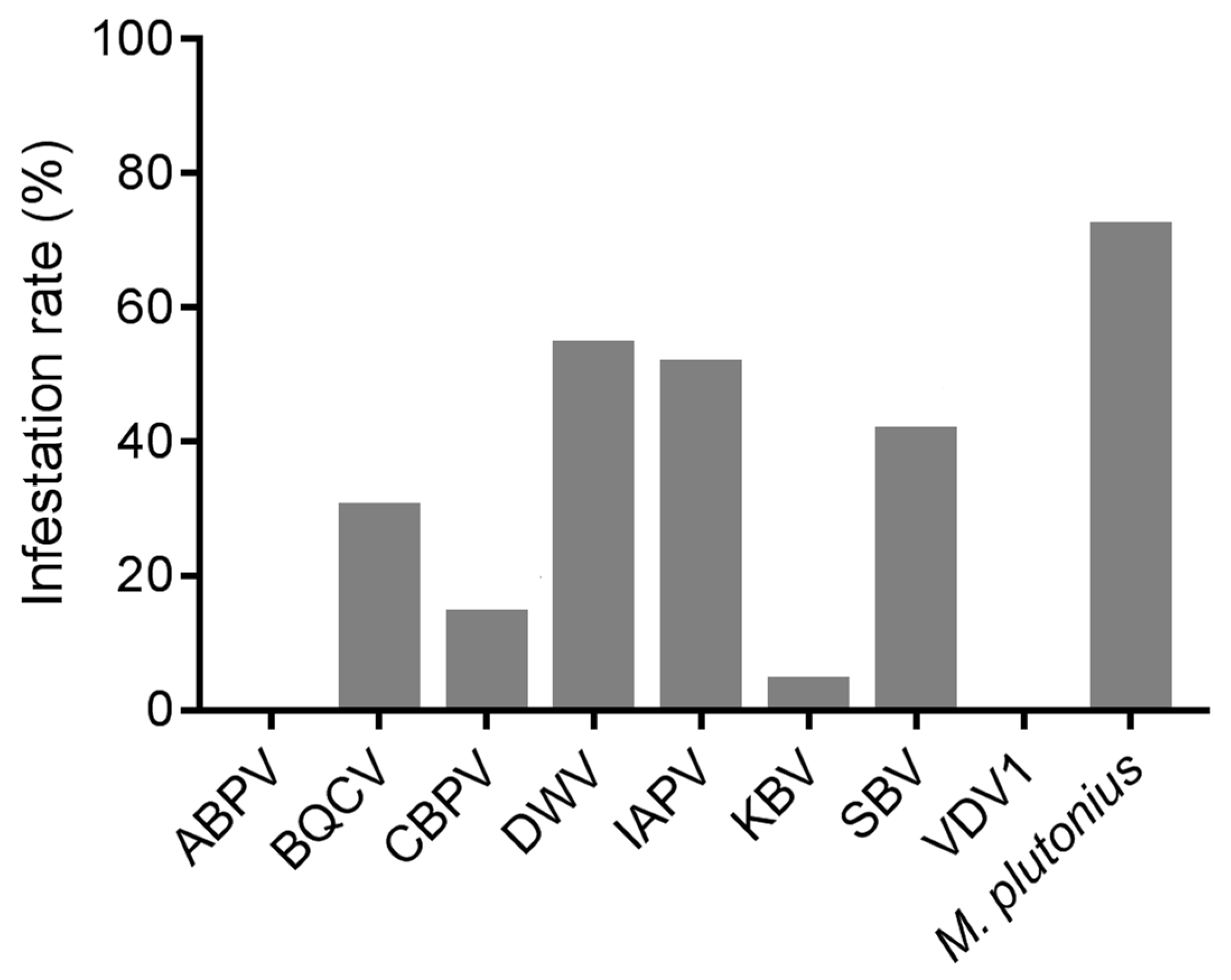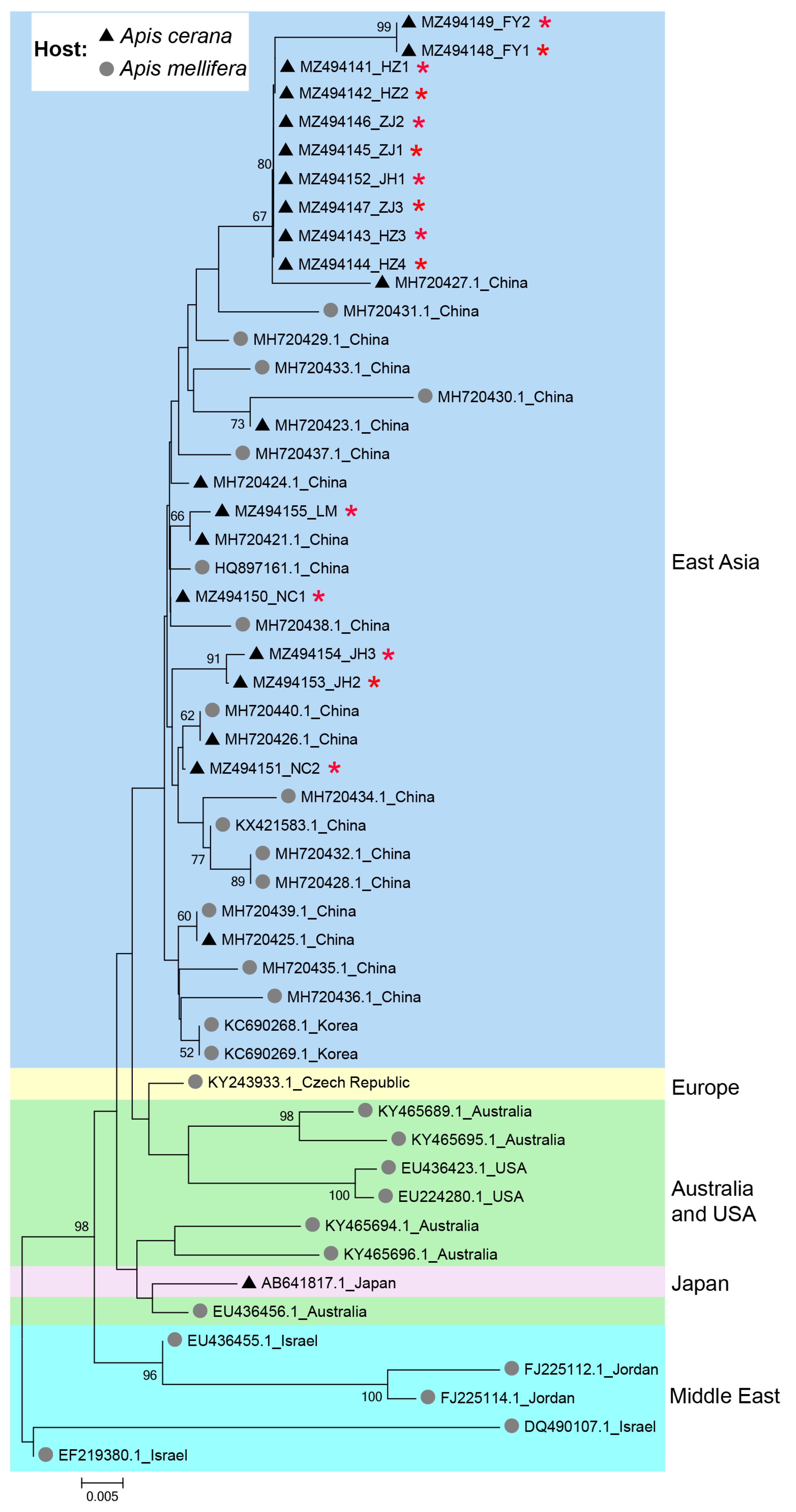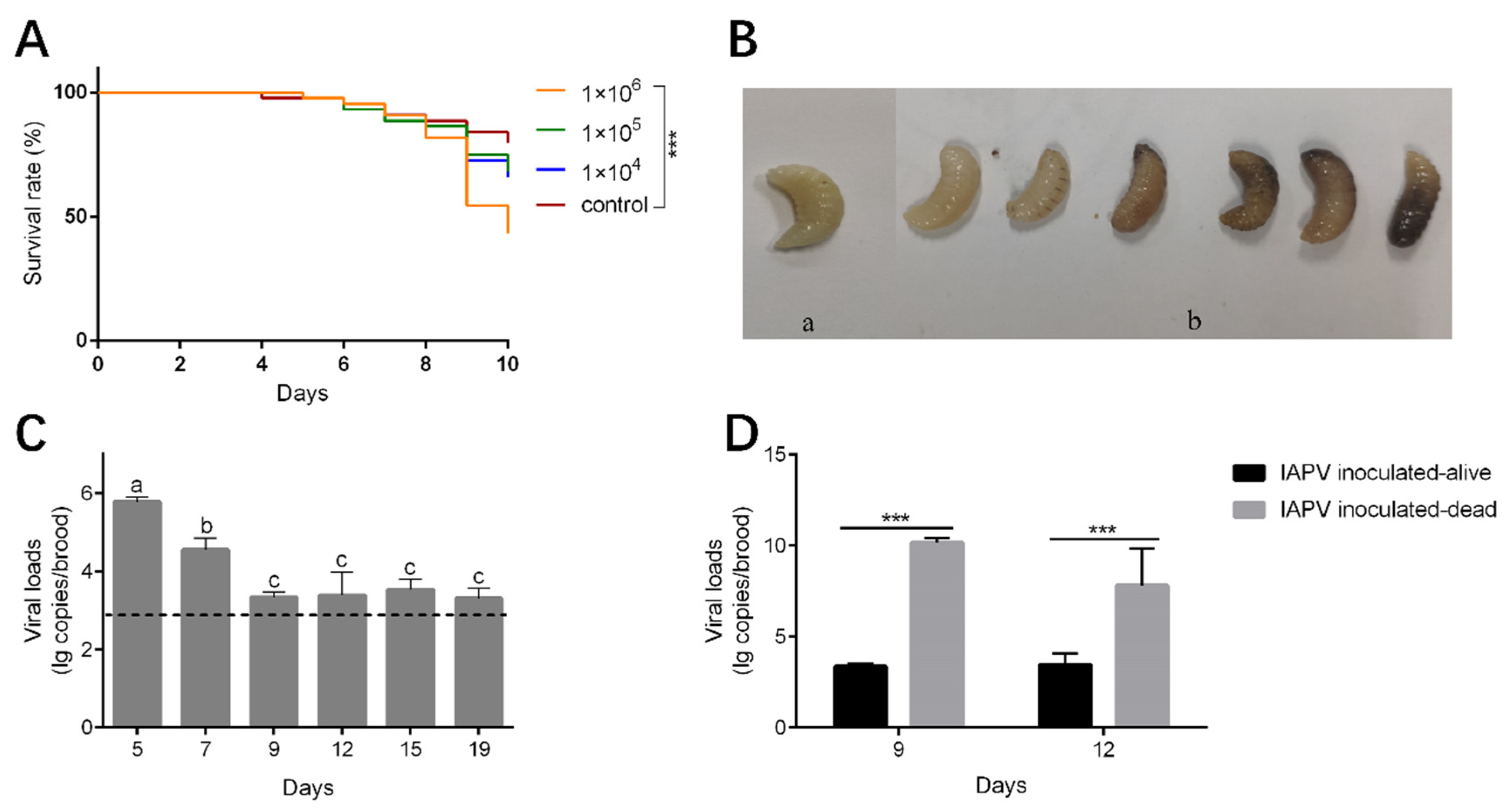Israeli Acute Paralysis Virus Is an Emerging Pathogen Contributing to Brood Disease of Apis cerana
Abstract
:1. Introduction
2. Materials and Methods
2.1. Sample Collection
2.2. DNA Extraction, RNA Extraction and cDNA Synthesis of Diseased Brood
2.3. Qualitative Detection of Common Bee Viruses and M. plutonius
2.4. Quantitative Real-Time PCR (qRT-PCR) Assays for Viral Load Quantification of Five Bee Viruses
2.5. Phylogenetic Analysis of IAPV Sequences
2.6. Preparation and Quantification of IAPV Solution
2.7. Virus Inoculation of A. cerana Larvae
2.8. IAPV Detection of Inoculated A. cerana Brood
2.9. Statistical Analysis
3. Results
3.1. Qualitative Detection of Pathogens in A. cerana Diseased Brood
3.2. Quantification of Viral Loads in Diseased Brood
3.3. Phylogenetic Tree of IAPV Isolates
3.4. Mortality and Viral Load of A. cerana Brood Inoculated with IAPV
4. Discussion
5. Conclusions
Supplementary Materials
Author Contributions
Funding
Institutional Review Board Statement
Informed Consent Statement
Data Availability Statement
Acknowledgments
Conflicts of Interest
References
- Evans, J.; Schwarz, R. Bees brought to their knees: Microbes affecting honey bee health. Trends Microbiol. 2011, 19, 614–620. [Google Scholar] [CrossRef]
- McMenamin, A.; Genersch, E. Honey bee colony losses and associated viruses. Curr. Opin. Insect Sci. 2015, 8, 121–129. [Google Scholar] [CrossRef] [PubMed]
- Hepburn, H.; Radloff, S. (Eds.) Honeybees of Asia; Springer Science & Business Media: Berlin/Heidelberg, Germany, 2011. [Google Scholar]
- Lin, Z.; Page, P.; Li, L.; Qin, Y.; Zhang, Y.; Hu, F.; Neumann, P.; Zheng, H.; Dietemann, V. Go east for better honey bee health: Apis cerana is faster at hygienic behavior than A. mellifera. PLoS ONE 2016, 11, e0162647. [Google Scholar] [CrossRef] [PubMed]
- Wei, R.; Cao, L.; Feng, Y.; Chen, Y.; Chen, G.; Zheng, H. Sacbrood virus: A growing threat to honeybees and wild pollinators. Viruses 2022, 14, 1871. [Google Scholar] [CrossRef] [PubMed]
- Maori, E.; Lavi, S.; Mozes-Koch, R.; Gantman, Y.; Peretz, Y.; Edelbaum, O.; Tanne, E.; Sela, I. Isolation and characterization of Israeli acute paralysis virus, a dicistrovirus affecting honeybees in Israel: Evidence for diversity due to intra- and inter-species recombination. J. Gen. Virol. 2007, 12, 3428–3438. [Google Scholar] [CrossRef] [PubMed]
- Li, Z.; Chen, Y.; Zhang, S.; Chen, S.; Li, W.; Yan, L.; Shi, L.; Wu, L.; Sohr, A.; Su, S. Viral infection affects sucrose responsiveness and homing ability of forager honey bees, Apis mellifera L. PLoS ONE 2013, 8, e77354. [Google Scholar] [CrossRef]
- Boncristiani, H.; Evans, J.; Chen, Y.; Pettis, J.; Murphy, C.; Lopez, D.; Simone-Finstrom, M.; Strand, M.; Tarpy, D.; Rueppell, O. In vitro infection of pupae with Israeli acute paralysis virus suggests disturbance of transcriptional homeostasis in honey bees (Apis mellifera). PLoS ONE 2013, 8, e73429. [Google Scholar] [CrossRef]
- Liu, Y.; Jia, S.; Wu, Y.; Zhou, N.; Xie, Y.; Wei, R.; Huang, Z.; Chen, Y.; Hu, F.; Zheng, H. Tetracycline-induced gut community dysbiosis and Israeli Acute Paralysis Virus infection synergistically negatively affect honeybees. Ecotoxicol. Environ. Saf. 2024, 282, 116706. [Google Scholar] [CrossRef]
- Kojima, Y.; Toki, T.; Morimoto, T.; Yoshiyama, M.; Kimura, K.; Kadowaki, T. Infestation of Japanese native honey bees by tracheal mite and virus from non-native European honey bees in Japan. Microb. Ecol. 2011, 62, 895–906. [Google Scholar] [CrossRef]
- Yañez, O.; Zheng, H.; Hu, F.; Neumann, P.; Dietemann, V. A scientific note on Israeli acute paralysis virus infection of Eastern honeybee Apis cerana and vespine predator Vespa velutina. Apidologie 2012, 43, 587–589. [Google Scholar] [CrossRef]
- Meeus, I.; de Miranda, J.; de Graaf, D.; Wäckers, F.; Smagghe, G. Effect of oral infection with Kashmir bee virus and Israeli acute paralysis virus on bumblebee (Bombus terrestris) reproductive success. J. Invertebr. Pathol. 2014, 121, 64–69. [Google Scholar] [CrossRef]
- Yang, S.; Gayral, P.; Zhao, H.; Wu, Y.; Jiang, X.; Wu, Y.; Bigot, D.; Wang, X.; Yang, D.; Herniou, E.; et al. Occurrence and molecular phylogeny of honey bee viruses in Vespids. Viruses 2019, 12, 6. [Google Scholar] [CrossRef] [PubMed]
- Levitt, A.; Singh, R.; Cox-Foster, D.; Rajotte, E.; Hoover, K.; Ostiguy, N.; Holmes, E. Cross-species transmission of honey bee viruses in associated arthropods. Virus Res. 2013, 176, 232–240. [Google Scholar] [CrossRef] [PubMed]
- Traiyasut, P.; Mookhploy, W.; Kimura, K.; Yoshiyama, M.; Khongphinitbunjong, K.; Chantawannakul, P.; Buawangpong, N.; Saraithong, P.; Burgett, M.; Chukeatirote, E. First detection of honey bee viruses in wax moth. Chiang Mai J. Sci. 2016, 43, 695–698. [Google Scholar]
- Wang, S.; Chen, G.; Lin, Z.; Wu, Y.; Hu, F.; Zheng, H. Occurrence of multiple honeybee viruses in the ectoparasitic mites Varroa spp. in Apis cerana colonies. J. Invertebr. Pathol. 2019, 166, 107225. [Google Scholar] [CrossRef]
- Chen, G.; Wu, Y.; Deng, J.; Wen, Z.; Wang, S.; Chen, Y.; Hu, F.; Zheng, H. Seasonal variation of viral infections between the eastern honey bee (Apis cerana) and the western honey bee (Apis mellifera). MicrobiologyOpen 2021, 10, e1162. [Google Scholar] [CrossRef] [PubMed]
- Ai, H.; Yan, X.; Han, R. Occurrence and prevalence of seven bee viruses in Apis mellifera and Apis cerana apiaries in China. J. Invertebr. Pathol. 2012, 109, 160–164. [Google Scholar] [CrossRef]
- Yang, B.; Peng, G.; Li, T.; Kadowaki, T. Molecular and phylogenetic characterization of honey bee viruses, Nosema microsporidia, protozoan parasites, and parasitic mites in China. Ecol. Evol. 2013, 3, 298–311. [Google Scholar] [CrossRef]
- Eva, F.; Shi, W.; Ding, G.; Liu, Z.; Toan, V.; Phuong, T.; Tuan, A.; Tam, Q.; Ingemar, F. Preliminary observations on possible pathogen spill-over from Apis mellifera to Apis cerana. Apidologie 2015, 46, 265–275. [Google Scholar] [CrossRef]
- Benjeddou, M.; Leat, N.; Allsopp, M.; Davison, S. Detection of acute bee paralysis virus and black queen cell virus from honeybees by reverse transcriptase PCR. Appl. Environ. Microbiol. 2001, 67, 2384–2387. [Google Scholar] [CrossRef]
- Ribière, M.; Triboulot, C.; Mathieu, L.; Aurières, C.; Faucon, J.P.; Pépin, M. Molecular diagnosis of chronic bee paralysis virus infection. Apidologie 2002, 33, 339–351. [Google Scholar] [CrossRef]
- Tentcheva, D.; Gauthier, L.; Zappulla, N.; Dainat, B.; Cousserans, F.; Colin, M.E.; Bergoin, M. Prevalence and seasonal variations of six bee viruses in Apis mellifera L. and Varroa destructor mite populations in France. Appl. Environ. Microbiol. 2004, 70, 7185–7191. [Google Scholar] [CrossRef]
- Di Prisco, G.; Pennacchio, F.; Caprio, E.; Boncristiani, H., Jr.; Evans, J.; Chen, Y. Varroa destructor is an effective vector of Israeli acute paralysis virus in the honeybee, Apis mellifera. J. Gen. Virol. 2011, 92, 151–155. [Google Scholar] [CrossRef] [PubMed]
- Stoltz, D.; Shen, X.; Boggis, C.; Sisson, G. Molecular diagnosis of Kashmir bee virus infection. J. Apic. Res. 1995, 34, 153–160. [Google Scholar] [CrossRef]
- Ma, M.; Li, M.; Cheng, J.; Yang, S.; Wang, S.; Li, P. Molecular and biological characterization of Chinese sacbrood virus LN isolate. Int. J. Genomics. 2011, 1, 409386. [Google Scholar] [CrossRef]
- Yanez, O.; Zheng, H.; Su, X.; Hu, F.; Neumann, P.; Dietemann, V. Potential for virus transfer between the honey bees Apis mellifera and A. cerana. J. Apic. Res. 2015, 54, 179–191. [Google Scholar] [CrossRef]
- Govan, V.; Brözel, V.; Allsopp, M.; Davison, S. A PCR detection method for rapid identification of Melissococcus pluton in honeybee larvae. Appl. Environ. Microbiol. 1998, 64, 1983–1985. [Google Scholar] [CrossRef]
- Blanchard, P.; Guillot, S.; Antùnez, K.; Köglberger, H.; Kryger, P.; de Miranda, J.; Franco, S.; Chauzat, M.; Thiéry, R.; Ribière, M. Development and validation of a real-time two-step RT-qPCR TaqMan® assay for quantitation of Sacbrood virus (SBV) and its application to a field survey of symptomatic honey bee colonies. J. Virol. Methods. 2014, 197, 7–13. [Google Scholar] [CrossRef]
- Thompson, J.; Gibson, T.; Plewniak, F.; Jeanmougin, F.; Higgins, D. The CLUSTAL_X windows interface: Flexible strategies for multiple sequence alignment aided by quality analysis tools. Nucleic Acids Res. 1997, 25, 4876–4882. [Google Scholar] [CrossRef]
- Tamura, K.; Stecher, G.; Peterson, D.; Filipski, A.; Kumar, S. MEGA6: Molecular evolutionary genetics analysis version 6.0. Mol. Biol. Evol. 2013, 30, 2725–2729. [Google Scholar] [CrossRef]
- Remnant, E.J.; Mather, N.; Gillard, T.L.; Yagound, B.; Beekman, M. Direct transmission by injection affects competition among RNA viruses in honeybees. Proc. R. Soc. B 2019, 286, 20182452. [Google Scholar] [CrossRef]
- Liu, S.; Wang, L.; Guo, J.; Tang, Y.; Chen, Y.; Wu, J.; Li, J. Chinese sacbrood virus infection in Asian honey bees (Apis cerana cerana) and host immune responses to the virus infection. J. Invertebr. Pathol. 2017, 150, 63–69. [Google Scholar] [CrossRef]
- Zhou, T.; Feng, F.; Dong, B. Study on the pathogen of European foulbrood in the Chinese honey bee (Apis cerana cerana F.). Acta Entomol. Sin. 2000, 43, 104–108. [Google Scholar] [CrossRef]
- Carrillo-Tripp, J.; Dolezal, A.; Goblirsch, M.; Miller, W.; Toth, A.; Bonning, B. In vivo and in vitro infection dynamics of honey bee viruses. Sci. Rep. 2016, 6, 22265. [Google Scholar] [CrossRef] [PubMed]
- Chen, Y.; Pettis, J.; Corona, M.; Chen, W.; Li, C.; Spivak, M.; Visscher, P.; DeGrandi-Hoffman, G.; Boncristiani, H.; Zhao, Y.; et al. Israeli acute paralysis virus: Epidemiology, pathogenesis and implications for honey bee health. PLoS Pathog. 2014, 10, e1004261. [Google Scholar] [CrossRef] [PubMed]
- Page, P.; Lin, Z.; Buawangpong, N.; Zheng, H.; Hu, F.; Neumann, P.; Chantawannakul, P.; Dietemann, V. Social apoptosis in honey bee superorganisms. Sci. Rep. 2016, 6, 27210. [Google Scholar] [CrossRef] [PubMed]
- Lin, Z.; Qin, Y.; Page, P.; Wang, S.; Li, L.; Wen, Z.; Hu, F.; Neumann, P.; Zheng, H.; Dietemann, V. Reproduction of parasitic mites Varroa destructor in original and new honeybee hosts. Ecol. Evol. 2018, 8, 2135–2145. [Google Scholar] [CrossRef] [PubMed]
- Brutscher, L.M.; Daughenbaugh, K.F.; Flenniken, M.L. Antiviral defense mechanisms in honey bees. Curr. Opin. Insect Sci. 2015, 10, 71–82. [Google Scholar] [CrossRef]




| Province | Locality | No. of Samples | Collection Year |
|---|---|---|---|
| Beijing | Haidian (HD) | 1 | 2018 |
| Chongqing | Rongchang (RC) | 1 | 2019 |
| Fujian | Fuzhou (FZ) | 1 | 2017 |
| Nanping (NP) | 1 | 2019 | |
| Guangdong | Longmen (LM) | 1 | 2017 |
| Hunan | Hengyang (HY) | 2 | 2018 |
| Jiangxi | Nanchang (NC) | 5 | 2018, 2019 |
| Shaanxi | Qinling Mountain (QL) | 1 | 2017 |
| Yunnan | Kunming (KM) | 4 | 2018 |
| Zhejiang | Fuyang (FY) | 3 | 2017, 2018 |
| Hangzhou (HZ) | 18 | 2017, 2019, 2020 | |
| Jinhua (JH) | 8 | 2017, 2019, 2020 | |
| Kaihua (KH) | 2 | 2020 | |
| Lishui (LS) | 6 | 2019 | |
| Longquan (LQ) | 4 | 2018 | |
| Longyou (LY) | 1 | 2019 | |
| Taishun (TS) | 2 | 2018 | |
| Yongkang (YK) | 2 | 2019 | |
| Zhuji (ZJ) | 7 | 2020 |
| Primer | Pathogen Name | Sequence (5′-3′) | Reference |
|---|---|---|---|
| ABPV-F | Acute bee paralysis virus | TTATGTGTCCAGAGACTGTATCCA | [21] |
| ABPV-R | GCTCCTATTGCTCGGTTTTTCGGT | ||
| BQCV-F | Black queen cell virus | TGGTCAGCTCCCACTACCTTAAAC | [21] |
| BQCV-R | GCAACAAGAAGAAACGTAAACCAC | ||
| CBPV-F | Chronic bee paralysis virus | AGTTGTCATGGTTAACAGGATACGAG | [22] |
| CBPV-R | TCTAATCTTAGCACGAAAGCCGAG | ||
| DWV-F | Deformed wing virus | GTCGTGCAGCTCGATAGGAT | [23] |
| DWV-R | TTTGCAAGATGCTGTATGTGG | ||
| IAPV-F | Israeli acute paralysis virus | GCGGAGAATATAAGGCTCAG | [24] |
| IAPV-R | CTTGCAAGATAAGAAAGGGGG | ||
| KBV-F | Kashmir bee virus | GATGAACGTCGACCTATTGA | [25] |
| KBV-R | TGTGGGTTGGCTATGAGTCA | ||
| SBV-F | Sacbrood virus | GACCCGTTTTCTTGTGAGTTTTAG | [26] |
| SBV-R | GTGTAGCGTCCCCCTGAATAGAT | ||
| VDV-1-F | Varroa destructor virus-1 | GCCCTGTTCAAGAACATG | [27] |
| VDV-1-R | CTTTTCTAATTCAACTTCACC | ||
| Mp-F | Melissococcus plutonius | GAAGAGGAGTTAAAAGGCGC | [28] |
| Mp-R | TTATCTCTAAGGCGTTCAAAGG |
| Primers | Pathogen Name | Sequence (5′-3′) | Reference |
|---|---|---|---|
| qBQCV-F | Black queen cell virus | GGAGTCGCAGAGTTCCAAAT | [17] |
| qBQCV-R | GTGGGAGGTGAAGTGGCTAT | ||
| qCBPV-F | Chronic bee paralysis virus | GGCACCTCAAGATCGTCCAAGTTAC | [17] |
| qCBPV-R | ACGGAGATGGTGACCTGGTATGG | ||
| qDWV-F | Deformed wing virus | CGTGGTGTAGTAAGCGTCGT | [17] |
| qDWV-R | TCATCCGTAGAAAGCCGAGT | ||
| qIAPV-F | Israeli acute paralysis virus | TCGCTGAAGGCATGTATTTC | [17] |
| qIAPV-R | ATTACCACTGCTCCGACACA | ||
| qSBV-F | Sacbrood virus | AACGTCCACTACACCGAAATGTC | [29] |
| qSBV-R | ACACTGCGCGTCTAACATTCC |
| No. of Viruses | Virus Species | No. of Samples | Ratio/% |
|---|---|---|---|
| 0 | 15 | 21.43 | |
| 1 | DWV | 3 | 4.29 |
| SBV | 3 | 4.29 | |
| BQCV | 2 | 2.86 | |
| IAPV | 2 | 2.86 | |
| CBPV | 1 | 1.43 | |
| 2 | BQCV, DWV | 5 | 7.14 |
| IAPV, SBV | 5 | 7.14 | |
| DWV, SBV | 4 | 5.71 | |
| DWV, IAPV | 2 | 2.86 | |
| BQCV, IAPV | 1 | 1.43 | |
| 3 | BQCV, DWV, IAPV | 6 | 8.57 |
| DWV, IAPV, SBV | 4 | 5.71 | |
| CBPV, DWV, IAPV | 3 | 4.29 | |
| CBPV, IAPV, SBV | 1 | 1.43 | |
| DWV, IAPV, KBV | 1 | 1.43 | |
| BQCV, DWV, SBV | 1 | 1.43 | |
| IAPV, KBV, SBV | 1 | 1.43 | |
| 4 | BQCV, DWV, IAPV, SBV | 5 | 7.14 |
| CBPV, DWV, IAPV, SBV | 3 | 4.29 | |
| CBPV, DWV, IAPV, KBV | 1 | 1.43 | |
| 5 | BQCV, CBPV, DWV, IAPV, SBV | 1 | 1.43 |
| Total | 70 | 100.00 |
Disclaimer/Publisher’s Note: The statements, opinions and data contained in all publications are solely those of the individual author(s) and contributor(s) and not of MDPI and/or the editor(s). MDPI and/or the editor(s) disclaim responsibility for any injury to people or property resulting from any ideas, methods, instructions or products referred to in the content. |
© 2024 by the authors. Licensee MDPI, Basel, Switzerland. This article is an open access article distributed under the terms and conditions of the Creative Commons Attribution (CC BY) license (https://creativecommons.org/licenses/by/4.0/).
Share and Cite
Xie, Y.; Wang, S.; Liu, Y.; Deng, J.; Su, X.; Huang, Z.; Zheng, H. Israeli Acute Paralysis Virus Is an Emerging Pathogen Contributing to Brood Disease of Apis cerana. Viruses 2024, 16, 1395. https://doi.org/10.3390/v16091395
Xie Y, Wang S, Liu Y, Deng J, Su X, Huang Z, Zheng H. Israeli Acute Paralysis Virus Is an Emerging Pathogen Contributing to Brood Disease of Apis cerana. Viruses. 2024; 16(9):1395. https://doi.org/10.3390/v16091395
Chicago/Turabian StyleXie, Yanling, Shuai Wang, Yao Liu, Jie Deng, Xiaoling Su, Zhichu Huang, and Huoqing Zheng. 2024. "Israeli Acute Paralysis Virus Is an Emerging Pathogen Contributing to Brood Disease of Apis cerana" Viruses 16, no. 9: 1395. https://doi.org/10.3390/v16091395
APA StyleXie, Y., Wang, S., Liu, Y., Deng, J., Su, X., Huang, Z., & Zheng, H. (2024). Israeli Acute Paralysis Virus Is an Emerging Pathogen Contributing to Brood Disease of Apis cerana. Viruses, 16(9), 1395. https://doi.org/10.3390/v16091395






